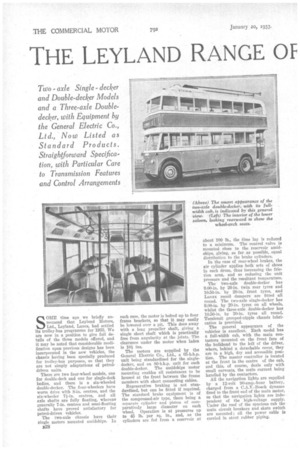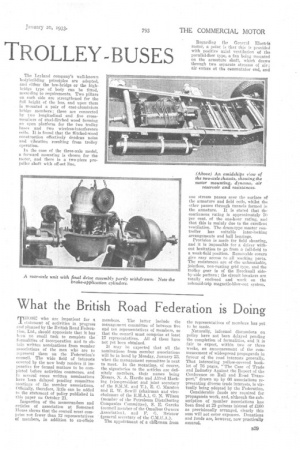THE LEYLAND RANGE OF
Page 42

Page 43

If you've noticed an error in this article please click here to report it so we can fix it.
TROLLEY BUSES
SCUE time ago we briefly announced that Leyland llotors, Ltd. Leyland, Lanes, had settled Its trolley-bus programme for 1933. We are now in a position to give full details of the three models offered, and it may be noted that considerable modification upon previous designs has been incorporated in the new vehicles, the chassis having been specially produced for trolley-bus purposes, so that they are not simply adaptations of petroldriven units.
There are two four-wheel models, one for double-deck and one for single-deck bodies, and there is a six-wheeled double-decker. The four-wheelers have worm drive with 8-in, centres, and the six-wheeler 7i-in. centres, and all axle shafts are fully floating, whereas generally 7-in, centres and semi-floating shafts have proved satisfactory for petrol-driven vehicles.
The two-axle chassis have their single motors mounted amidships. Iu B28
each case, the motor is bolted up to four frame bracket; so that it may easily be lowered over a pit. This does away with a long propeller shaft, giving a single short shaft which is practically free from angularity at the joints. The clearance under the motor when laden is 10i ins.
The motors are supplied by the General Electric Co., Ltd., a 65-b.h.p. unit being standardized for the singledecker, and an 80-13.h.p. unit for each double-decker. The amidships motor mounting enables all resistances to be housed at the front between the frame members with short connecting cables.
Regenerative braking is not standardized, but can be fitted if required. The standard brake equipment is of the compressed-air type, there being a separate cylinder and piston of comparatively large diameter on each wheel. Operation is at pressures up to 45 lb. per sq. in., and, as the cylinders are fed from a reservoir at
about 100 lb., the time lag is reduced to a minimum. The control valve is mounted close to the reservoir amidships, giving, so far as possible, equal distribution to the brake cylinders.
In the case of rear-wheel brakes, the air cylinder applies -both sets of shoes in each drum, thus increasing the friction area, and so reducing the unit pressure and the resultant temperature.
The two-axle double-decker has 9.00-in. by 20-in, twin rear tyres and 10.50-in. by 20-in, front tyres, and Luvax recoil dampers are fitted all round. The two-axle single-decker has 9.00-in. by 20-in. tyres an all wheels, whilst the three-axle double-decker has 10,50-in. by 20-in. tyres all round. Tecalemit grouped-nipple chassis lubrication is provided.
The general appearance of the vehicles is excellent. Each model has a full-width cab, with the main contactors mounted an the front face of the bulkhead to the left of the driver, where, behind a detachable cover, they are in a high, dry and accessible position. The master controller is located at the front in the centre of the cab, and this, of course, deals only with small currents, the main current being handled by the contactors.
All the navigation lights are supplied by a 12-volt 90-amp.-hour battery, charged from a C.A.V.-Bosch dynamo fixed to the front end of the main motor, so that the navigation lights are independent of the high-voltage supply. Under the roof of the spacious cab the main circuit breakers and skate switch are mounted ; all the power cable is carried in stout rubber piping.
The Leyland company's well-known bodybuilding. principles are adopted, and either the low-bridge or the highbridge type of body can be fitted, according to requirements. Two pillars on each side are strengthened for the full height of the bus, and upon them is mounted a pair of cast-aluminium bridge members; these are connected by two longitudinal and five crossmembers of steel-ffitched wood forming on open platform for the two trolley bases and two wireless-interference coils. It is found that the flitched-wood construction effectively deadens noise and vibration resulting from trolley operation.
In the ease of the three-axle model, a forward mounting is chosen for the motor, and there is a two-piece pro peller shaft with off-set line, • Regarding the Genenil Electr motor, a point is that this is provided with positive axial ventilation of the parallel-flow type, a fan being mounted on the armature shaft, which draws through two separate streams of air; air enters at the commutator end, and.
one stream passes over the surface of the armature and field coils, whilst the other passes through tunnels formed in the armature. It is stated that the continuous rating is approximately 70 per cent. of the one-hour rating, and that this is mainly due to the excellent ventilation. The drum-type master controller has suitable inter-locking arrangements and ball bearings.
Provision is made for field shunting, and it is impossible for a driver 'without hesitation to go from a full-field to a weak-field position. Removable covers give easy access to all working parts. The resistance are of -the unbreakable, jointless, non-rusting grid type, and the trolley gear is of the Brecknall sideby-side pattern ; the circuit breakers are totally enclosed and work on the solenoid-trip magnetic-blow-out system.




























































































